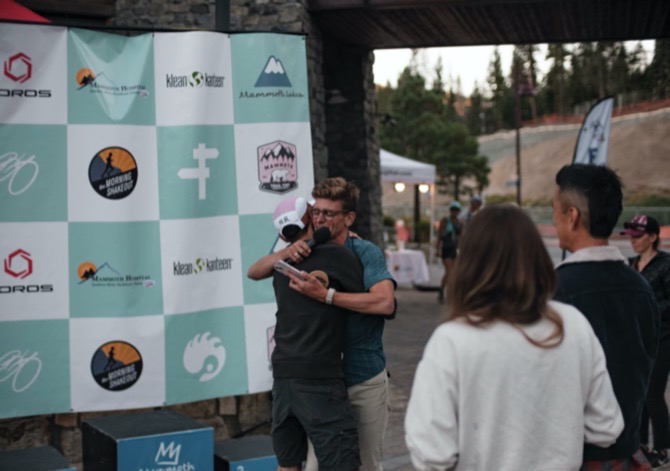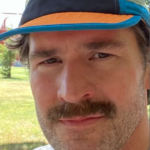The inaugural Mammoth Trail Festival was this past weekend, and if you didn’t get to be there in person let me tell you – it was more than just a running race! Clinics, group runs, live podcasts, film showings, and talks highlighted each day including a discussion led by Psychotherapist Michael J. Loeffler called “How Your Story Shapes You”. He was joined by Adam Campbell, Katie Asmuth, and Sofia Carolina Flores to discuss how the stories we tell ourselves affect how we understand and address everything that makes us human from loss and injury to balancing work and family. Here Michael continues that rumination on how we waltz (or are sometimes flung) from one chapter to the next.

Sometime along the trail of life an event occurs that launches you from one type of trail runner to another.
This is an opportunity for a massive transformation but often it’s experienced as loss. Truth is it’s a little bit of both. It can be sudden – a physical injury, a health crisis, a life event. At other times it may come as an internal injury such as a lack of motivation, a loss of the ‘why’ for your training, depression. Yet anyway you slice it, if it’s powerful enough, it creates a demarcation between who you were and who you are. The transformation is often overlooked, missed, or worse yet simply categorized as a mid-life crisis. But this is no longer a sufficient description and misses the mark entirely. This passage is an opportunity to not only become a better athlete but a better human – unfortunately, again, it’s often accompanied with loss.
C.G. Jung was the first to popularize the idea of a mid-life, and argued it occurs roughly around 35 years of age. What is striking about trail and ultrarunning is that most runners are already in the second half of their ‘running life’ with an average age well over 35, some stating the average to be closer to 42 or 43 years old. This may skew a little younger or older as trail races move from shorter to longer distances, such as the Golden Trail Series or the Transcendence 3100. The number isn’t as important as the gravity of the change, but it is fair to say that by this age you somehow have already experienced some form of a fall or challenge.
The first half of life is usually a bit unconscious. What I mean by this is that we aren’t at all aware of our blessings or curses. We often don’t know how healthy we are until we lose it for some period of time. We can carry on in reckless abandon.
Hillary Allen, who has faced tragedy and injury, in an early interview on the Freetrail podcast, stated it’s important to not think of these moments of crisis as simply an impetus for a comeback. Had she merely wanted to return to her previous state she would have never had the opportunity to move forward as a better athlete and person. As she says, ‘your best running days are ahead of you’ and we must maintain this attitude. It may no longer be about faster times but instead a more wholesome you. This attitude doesn’t come easy and it’s inherently fraught. You have to feel a little ‘not normal’ for a time before coming into your new life as an athlete. For some it’s extreme or abrupt such as Hillary’s story but it’s no less important if your change is less extreme. It’s still a change from one type of life to a whole new one.

Let’s compare the first half of life to the second and how it relates to running. Sorry to say young guns, but you have a tendency to be reckless in relationships, running, and life! That’s not always a bad thing. You have to learn where your limits are and how to discipline your ego to work hard… but this is no pass to burn the candle at both ends. If you decide to do this, then you have to accept the consequences. I certainly have had my late nights followed by long runs in the heat, but with age comes wisdom. Perhaps you are sitting here wondering if it will change, if you will change? It will, you will. Perhaps you also wonder if you’ll be a better athlete when this change occurs and let me tell you – yes, yes you will.
Runners in the early years are fierce in their approach to accumulated miles – but aren’t most young people in their endeavors? The bottom line is that the first half of life is a time where there is no time, there is no end of time insofar that you can’t even imagine life having an end at all. It’s as if you are in Peter Pan’s Never Never Land, the eternal boy or girl. This is a special time in life but not many folks are aware that they are even there. This is the time when your speed may keep improving, contracts are getting signed, brands approach you. This recognition is magical but reach out and learn from the grizzled veterans because times change, and that’s okay.
Then something happens…
To this day God is the name by which I designate all things which cross my willful path violently and recklessly, all things which upset my subjective views, plans and intentions and change the course of my life for better or worse.
C.G. Jung
…the second half of life comes knocking on your door.
You get injured, you lose someone, your recovery seems longer, you fall in love or out of it, you move, you take on a mortgage, you have a baby, the day time job isn’t working for you, you might need more income, the demands pile on and you may need to clip your runs or sleep short. These ‘intrusions’ can be ignored for a time in the first half of life but now you can no longer ignore them.
If you can reframe these intrusions as messengers from deep within you you’ll find great gold. The niggle and the hot spot are a message and metaphor you need to address. By now, hopefully you’ve learned from time and experience how some messages must be listened to. In training we lean into things like the accumulated fatigue of a high training stress score, or heart rate monitors, HRV, or other wearable technologies that are supposed to tell us how, “How am I?”. We rely on quantifying ourselves instead of understanding ourselves. But if you really listen to those deep messengers you’ll find you don’t need to be quantified, you just need to be heard.
These are the maturation signs of an athlete and why I believe the mature individual does so well in this incredibly hard sport. We all love comeback stories, and victory for the athlete in the second half of life is all the sweeter because we appreciate that time is not infinite. Many athletes and patients wrestle with this change and as hard as it might be for you too…stay with it. Listen to it. This is when we take the leap into a deeper calling in the sport. This is when the real heroine or hero story begins, because this is when you are running with the conscious meaning we unknowingly spend the first half of life searching for.

